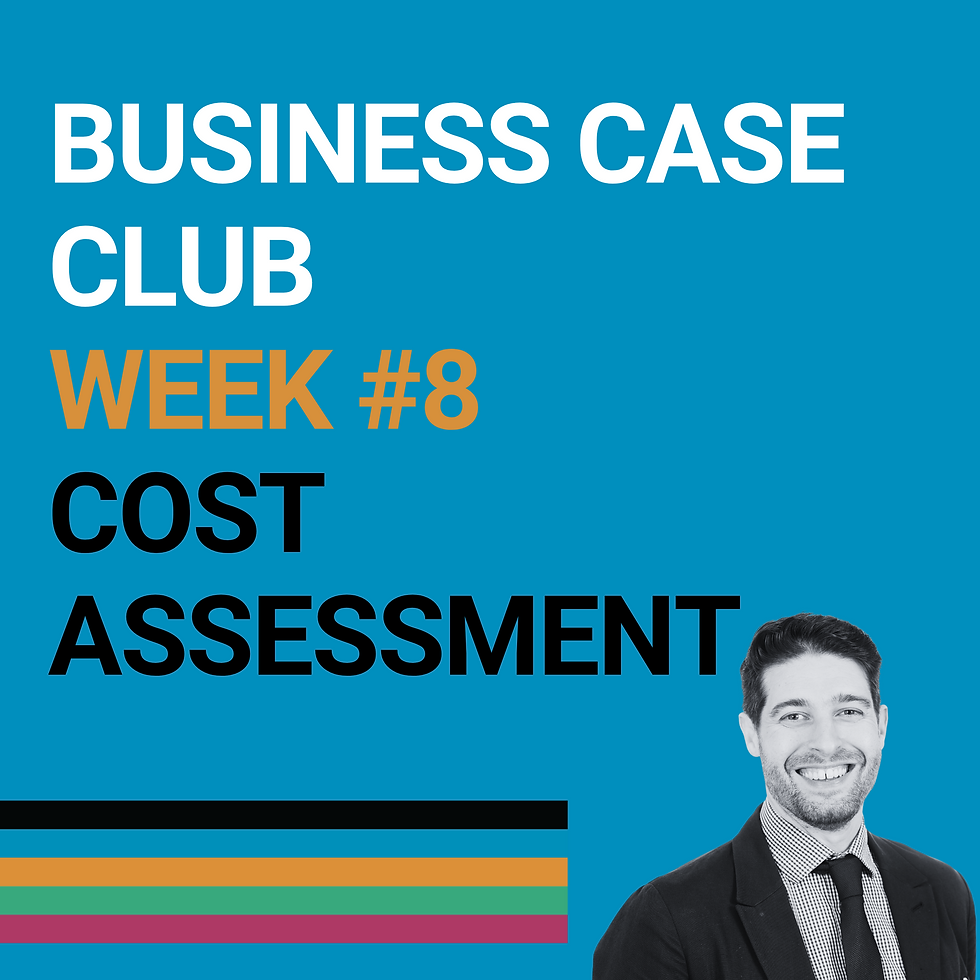Business Case Club Week #8: Cost Assessment
- gbp group

- Nov 5, 2024
- 5 min read

In the latest instalment of our Business Case series, we focus on financial modelling – both Capital and Revenue costs - and determining if the scheme is affordable. This instalment is a detailed one, so get comfy and grab a
You’ve been through the feasibility options, you’ve assessed the longlist to create a shortlist, you’ve undertaken a risk appraisal and a benefits appraisal.
So, what's next?
Have you worked out what each option will cost?
Will these be one off costs or ongoing costs?
Do you need to apply VAT or not?
Do you need optimism bias or a contingency – or both?
To complete the Economic Appraisal, and provide the underlying information for the Financial Appraisal, you need to determine the various costs for each option. For most Business Cases, these typically fall into the two categories - Capital and Revenue:
Capital costs typically include: | Revenue costs typically include: |
Land Costs | Rent |
Stamp Duty | Rates |
Construction/build costs | Utilities |
Construction/ fees | Clinical Waste |
Decant Costs | Services Charges & Management Fees |
Temporary Accommodation Costs | Staff Costs & Salaries |
Lifecycle Costs | Temporary Accommodation Costs could be revenue or capital, e.g. buy a portacabin or rent one |
✏️ Top Tip: Costs are one of the areas that undergo the greatest level of scrutiny, by all parties! So, ensuring the right costs are assessed for the different areas of the Business Case is key. The same cost may look different dependent on whether you’re looking at the costs from an Economic perspective (to determine Value for Money) or the Financial perspective (to determine affordability and cash flows).

Once you have determined the costs, risks and benefits, you can prepare the Economic Appraisal to determine the Value for Money Preferred Option
(Keep an eye out for more detail on Value for Money in next week’s blog).
However, the costs that will be included as part of the cash flow assessment will need to be adjusted for inflation, VAT, other circular payments and other possible adjustments.
Taking a simplistic example, the construction costs for a new build may be estimated at £20m, excluding VAT and inflation. This would be the Economic Case value. However, for cashflow purposes, you need to:
understand whether the VAT costs are recoverable (and by who
have these costs been inflated to present the expected timing of when the cashflows will be incurred?
what is the phasing of the costs – will they all be incurred in a single financial period or over a number of years (resulting in different inflationary costs)?
do the costs include contingencies? Has Optimism bias been included?
Essentially, the Financial Case analysis is focused on what will actually need to be paid, by who, and in what timeframe.
A summary of the differences between the two views of costs is set out below:
Economic Appraisals | Financial Appraisals |
Focus: Net Present value – Public value for money | Focus: Funding and affordability – cashflow and stock |
Coverage: Society as a whole | Coverage: Relevant Public Organisation(s) budget |
Relevant Standards:
| Relevant Standards:
|
Analysis:
| Analysis:
|
For most Business Cases, you will need to present the costs from both perspectives and, therefore, having a model which helps you calculate and then present this (in a summary and easy to understand format!) is key.
Other key issues to consider in relation to costs:
Optimism Bias
This is an economic concept relevant to public sector Business Cases, which is defined in HM Treasury’s Green book as follows:
“Optimism bias is the systematic tendency for appraisers to be over-optimistic about key project parameters, including capital costs, operating costs, project duration and benefits delivery. This is particularly common in the early stages of developing and costing projects (e.g. at SOC and OBC stage)”
To reduce this tendency, appraisals should make explicit adjustment for optimism bias, typically included as a percentage of capital costs and included in the Economic Case as an additional capital cost. The Green Book recommends applying overall percentage adjustments at the outset of an appraisal.
This additional cost adjustment is intended to capture increases in costs between OBC and FBC to reflect unexpected changes to the scope of projects (due to, for example, changes in national policy, local priorities or strategies). It also reflects the tendency for costs to increase as more detailed design work and consultation are undertaken. However, it is important to note that adjustments for optimism bias are not the same as financial contingency – these reflect known uncertainties, whereas Optimism Bias essentially represents the “unknown unknowns”
So, what does that all mean?
Basically, there is a tendency to under-egg the costs to try and get the scheme to be affordable and viable, so an adjustment needs to be included to reflect this. However, as projects develop and costs become more certain and unknowns become known, this percentage reduces, typically to the point of 5% or less, at the point a Final Business Case is submitted.
VAT
Whilst this is excluded from the Economic case analysis, the treatment of VAT can have a significant effect on affordability, so you need to understand the VAT treatment for financial case analysis.
Simplistically, where a building has been Opted to Tax, the VAT will be recoverable on the construction costs (typically recovered by the developer and, therefore, the net construction costs will be charged to the public sector). However, this means that rent and service charges will have VAT applied when charging the public sector partner, thereby increasing the ongoing running costs for the public sector.
Whilst this is a simplistic example, VAT and its treatment needs to be carefully considered and we recommend you obtain professional advice in respect of this.
⭐Success Story: The redevelopment of Northwood & Pinner Cottage Hospital
In the case of the Northwood & Pinner development, the gbp consult Business Case team supported NHS Property Services (NHSPS) to prepare both an OBC, FBC and subsequent summarised (short form) reports, for various governing bodies.

A detailed model, over 60+ years, providing both the Economic, Financial and Tenants views was developed by the NHSPS Finance and Analytics teams, which gbp consult then reviewed and summarised for reporting purposes, providing explanations for the costs bases and implications. This meant expressing complex financial analyses in a simplified, understandable way, for both finance and non-finance readers.
Need help now?
Arrange a conversation with our expert Business Case Team. Contact Ian Sabini, Managing Consultant on: ian@gbpconsult.co.uk
Coming up next in our series of Business Case Club Blogs:
Curious to find out more or have a pressing question?
Tell us what topics you'd like explored in more detail in an upcoming webinar by filling out this brief form.





Comments